December’s stunning Geminid meteor shower is born from a humble asteroid
How does a space rock make such an impressive display of shooting stars?

The Geminid meteor shower produces a vivid display of shooting stars every December, but unlike most meteor showers, the show is from an asteroid, not a comet.
Jeff Dai
On Sunday night, December 13, countless meteors will shoot across the sky as space particles burn up in our atmosphere and meet a fiery end. Most meteor showers occur when Earth slams into debris left behind by a comet.
But not this meteor shower, which is likely to be the most spectacular of the year. Known as the Geminid shower, it strikes every December and arises not from a flamboyant comet but from an ordinary asteroid — the first, but not the last, linked to a meteor shower.
Although both comets and asteroids are small objects orbiting the sun, icy comets sprout beautiful tails when their ice vaporizes in the heat of the sun. In contrast, asteroids have earned the name “vermin of the skies” for streaking through and ruining photographs of celestial vistas by reflecting the sun’s light.
So how can a mere asteroid outdo all of the glamorous comets and spawn a meteor shower that surpasses its rivals? “It remains a mystery,” says David Jewitt, an astronomer at UCLA. It’s akin to an ugly duckling’s offspring usurping the beautiful swan’s to win first place in a beauty contest.
Astronomers still don’t know the secret to the asteroid’s success in creating a shower that at its peak normally produces more meteors per hour than any other shower of the year. Three years ago, however, the asteroid swung extra close to Earth and gave scientists their best chance to study the humble space rock. They now look forward to the launch of a spacecraft that will image the asteroid’s surface.
Sign up for our newsletter
We summarize the week's scientific breakthroughs every Thursday.
Cosmic connections
Astronomers first linked a meteor shower to a comet in 1866. They connected the well-known Perseid meteors, visible to most of the world every August, with a comet named Swift-Tuttle that had passed Earth four years earlier. Astronomers later matched most major meteor showers with one comet or another.
When a comet’s ice vaporizes in sunlight, dust grains also fly off the comet. These dust particles, called meteoroids, sprinkle along the comet’s orbit like a dandelion gone to seed. If Earth plows into this long dust stream, we see a fiery shower as the particles hit our atmosphere. The typical meteoroid is no larger than a grain of sand, but it travels so fast that it energizes electrons both in its own atoms as it disintegrates and in atmospheric atoms and molecules. As these electrons lose energy, they emit the streak of light — the meteor — that looks as though a star has fallen from the sky.
Still, as comet after comet was linked to different meteor showers, the Geminids remained apart; no one knew their source.
The Geminid meteors stood out in other ways, too. Unlike the Perseid meteors, which people have been observing for nearly 2,000 years, the Geminids are relatively new. First reports of their existence came from England and the United States in 1862. The shower in those days was weak, producing at most only one or two dozen meteors an hour. During the 20th century, however, the shower strengthened. Nowadays, at the shower’s peak, a single observer under a dark sky can see more than 100 meteors an hour. That’s better than most Perseid performances.
On top of that, the Geminid meteoroid stream, the ribbon of dust that traces the asteroid’s orbit around the sun, is newer than many other streams. Over time, streams spread out, but this one is so narrow it must have formed less than 2,000 years ago and maybe only a few hundred years ago. And based on how little the meteoroids slow down when they hit the air, astronomers deduced that Geminid meteoroids are fairly dense, about three times as dense as water and twice as dense as the Perseid meteoroids.
Meteor-maker
The asteroid Phaethon, which produces the annual Geminid meteor shower, orbits the sun on a highly elliptical path that takes the small body from well inside the orbit of Mercury to beyond the orbit of Mars.
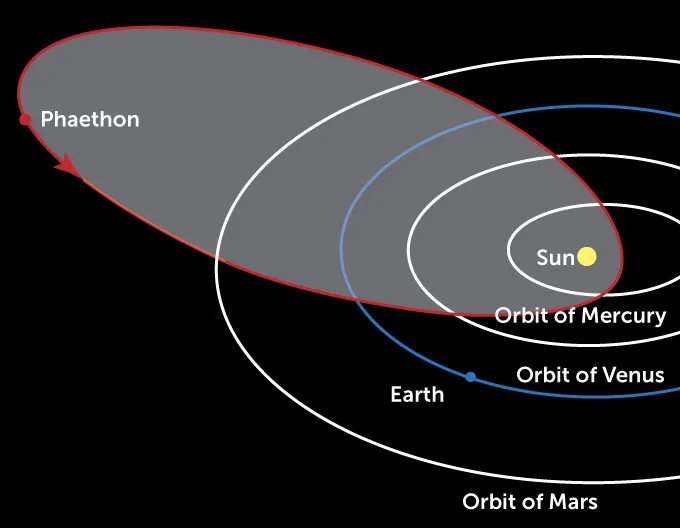
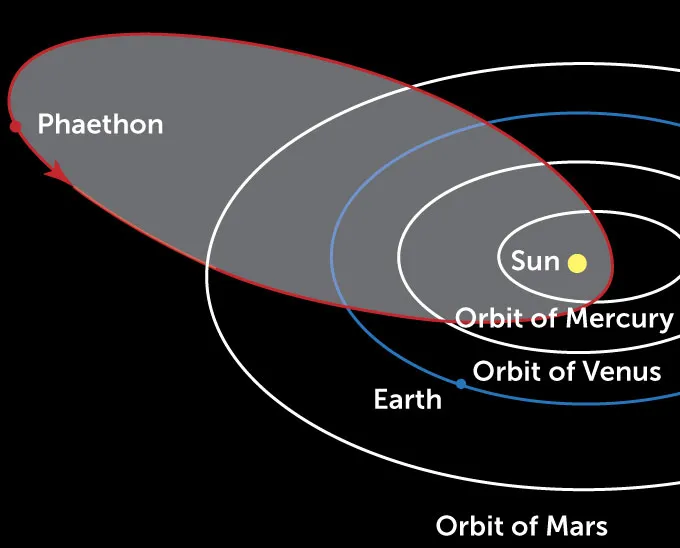
In 1983, astronomers finally found the Geminids’ parent. Jewitt, then a graduate student at Caltech, remembers walking home one January evening when he happened to see a rocket lift off from a military base. “I assumed it was an ICBM or something that the Air Force was launching to test,” he says. Instead, it was a heat-seeking spacecraft named the Infrared Astronomical Satellite.
In October of that year, the satellite discovered a small asteroid. To Harvard astronomer Fred Whipple, best known for his “dirty snowball” model of comets (SN: 3/14/92, p. 170), that small object stood out. It followed the same path around the sun as the particles in the Geminid meteoroid stream. Half a century earlier, Whipple himself had determined the orbit of the meteoroids by photographing the paths of the meteors against the sky. The newfound asteroid, Whipple declared, must be their long-sought source. The find also explained why the meteoroids were so dense: They come from a space rock rather than an icy comet.
The asteroid revolves around the sun every 1.43 years and comes very close to the sun, cutting well inside the orbit of Mercury, the innermost planet. Astronomers therefore christened the asteroid Phaethon, a son of Helios the sun god in Greek mythology. At its farthest, Phaethon ventures beyond the orbit of Mars and reaches the asteroid belt, home of the largest space rocks, between the paths of Mars and Jupiter.
For a quarter century after Phaethon’s discovery, though, no one saw it shedding any dust particles or pebbles that could account for the many meteors that make up December’s show. Because of the sun’s glare, astronomers couldn’t observe Phaethon when it was closest to the sun. Observing during a close pass might be especially interesting because calculations indicated that the intense sunlight caused Phaethon’s surface temperature to soar to roughly 1,000 kelvins (1,340° Fahrenheit), hotter than any planet in the solar system. The torrid temperature might cause the asteroid to shoot particles into space.
A lucky break came about because Jewitt married an astrophysicist who studies the sun. “Really, the key was talking to my wife about this,” he says. Jing Li, also at UCLA, and Jewitt realized that a solar spacecraft might be able to pick up details about the asteroid when it’s nearest the sun and thus offer clues to why the space rock is such a fertile meteor-maker.
Sure enough, in 2009 and again in 2012, images taken by a NASA solar spacecraft named STEREO A caught Phaethon brightening when near the sun, which suggested the asteroid was throwing off dust particles. Then, in 2013, Jewitt and Li noticed a short dust tail in that data. The tail lasted only two days. “It’s really, really faint in basically the world’s crappiest data,” Jewitt says. The bright background sky makes the tail hard to see.
The researchers attribute Phaethon’s dust production to the extreme heat, which breaks rocks on the asteroid’s surface and sends particles aloft. Phaethon has so little gravity that those particles can escape into space. Additional dust may result from desiccation, Jewitt says: In the presence of such heat, hydrated minerals on the asteroid may dry out and crack, the way empty lake beds do on Earth, releasing more particles.
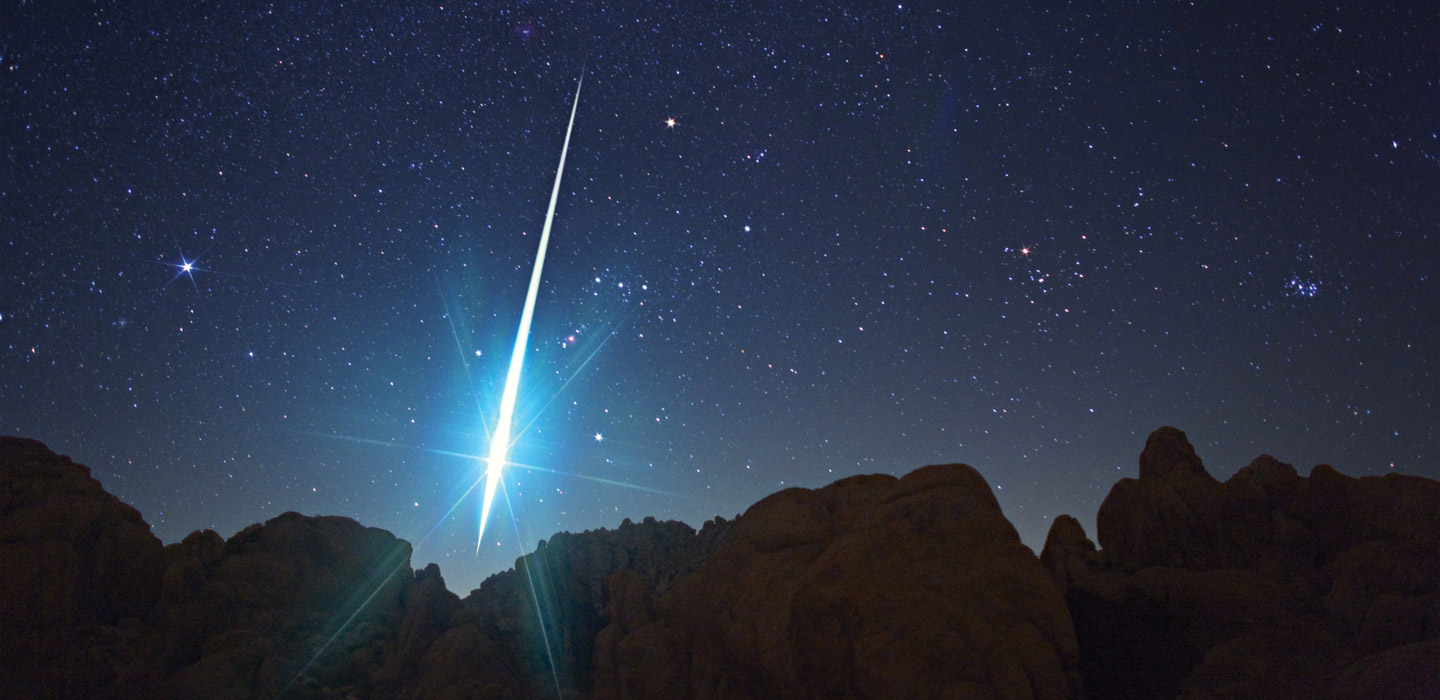
Phaethon’s fast spin causes further stress. The asteroid makes a full turn every three hours and 36 minutes. Such rapid rotation is typical of small asteroids, and it means the surface freezes and then fries over a short period of time. The spin also creates a centrifugal force that might help lift particles into space.
Yet these findings don’t solve the mystery of how a modest asteroid produces such a stunning meteor shower, Jewitt says. For one thing, as he and colleagues noted in 2013 in the Astrophysical Journal Letters, the particles in Phaethon’s temporary tail are much too small.
Most of the Geminid meteors we see come from particles roughly a millimeter across. But the particles in the tail are even tinier, spanning only about one one-thousandth of a millimeter. Jewitt and Li deduced the small size because sunlight exerts radiation pressure, which is weak, that pushes the tail straight back away from the sun; if the particles were larger, they would resist the weak pressure and the tail would be curved.
Plus, Phaethon’s close passages to the sun don’t eject nearly enough particles to populate the Geminid stream. This suggests that some catastrophe hit the asteroid in the recent past and made so many meteoroids that they continue to delight meteor observers today.
In 2014, astronomer Richard Arendt of the University of Maryland, Baltimore County reported the first direct sighting of the Geminid meteoroid stream itself. He had reanalyzed old data from a spacecraft whose chief mission had nothing to do with the solar system: the Cosmic Background Explorer, which NASA had launched a quarter century earlier to study the Big Bang’s afterglow and probe the universe’s birth.
“They didn’t really have the tools to look at the data in the right way back then,” Arendt says. With modern computers, he made movies of the data and glimpsed glowing strands of dust threading the solar system that emit infrared light as the sun heats them. He used this approach to view the never-before-seen dust trail along the orbit of Halley’s comet, as well as Phaethon’s dust trail: the Geminid meteoroid stream, which looked like a narrow filament along Phaethon’s orbit. Arendt published his work in the Astronomical Journal.
More recently, NASA’s Parker Solar Probe also detected the stream (SN: 1/18/20, p. 6). “This is the first time it’s been seen in visible light,” says Karl Battams, an astrophysicist at the U.S. Naval Research Laboratory in Washington, D.C. Sunlight hits the dust, reflecting the light to the probe. The observations put the stream’s mass at roughly 1 percent that of Phaethon itself. This is much more material than the asteroid produces when closest to the sun, which Battams says again favors the idea that the bulk of the Geminid meteoroid stream owes its existence to some past catastrophe.
Phaethon visits Earth
In December 2017, the asteroid helped astronomers by flying only 10 million kilometers from Earth, the closest the rock will come until 2093. “This was a great opportunity to look at Phaethon,” says Patrick Taylor, an astronomer then at Arecibo Observatory in Puerto Rico.
Hurricane Maria had devastated the island and damaged the radio telescope just three months earlier, yet the observations succeeded. “That was the result of a tremendous amount of effort by the observatory staff, the community and the local government,” Taylor says. The telescope was repaired, and commercial power was restored to the observatory by clearing roads and replacing downed poles and cables to the site. “Everyone was aware how important this observation was going to be,” he says.
Over a period of five days, his team bounced radar signals off the asteroid, watching different features come into view as the rock rotated. As published in 2019 in Planetary and Space Science, the observations indicate that Phaethon’s equatorial diameter is about 6.25 kilometers, which means the asteroid is a bit more than half the size of the one that hit Earth and did in the dinosaurs (SN: 2/15/20, p. 7). The images show what may be craters, one more than a kilometer across, on Phaethon’s surface. There’s also a possible boulder 300 meters wide.
The radar images suggest Phaethon isn’t perfectly round. Instead, it may resemble a spinning top, like Bennu and Ryugu, two even smaller asteroids that spacecraft have recently visited. Both of those asteroids have equatorial diameters larger than their polar diameters. More than a thousand Bennus could fit inside Phaethon, but the two asteroids have similar shapes, Taylor notes. He thinks Phaethon may owe its shape to its rapid spin.
Speedy spinner
Radar images from December 2017 show some details on Phaethon as it rotates. A Japanese mission named DESTINY+, scheduled to launch in 2024, should yield a much better view.
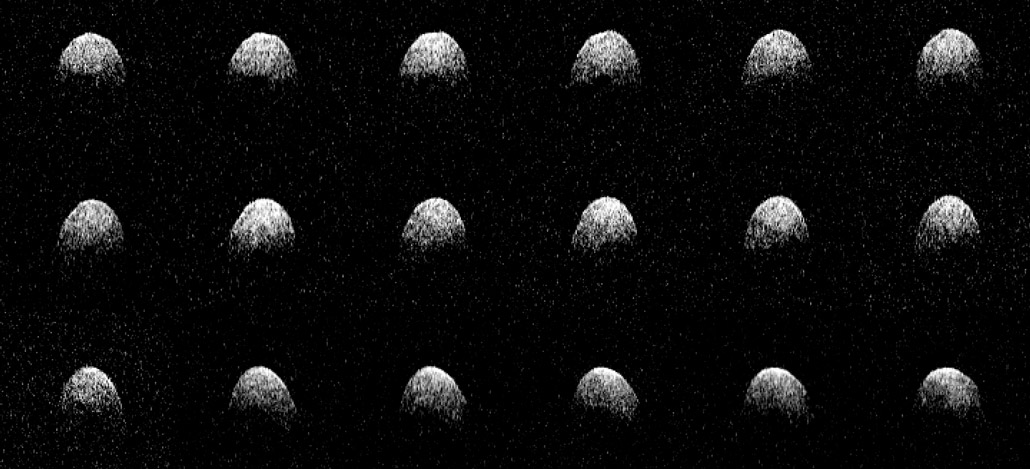
Jewitt also tried to take advantage of Phaethon’s close visit. “It was a bit of a letdown,” he says, laughing. “We saw absolutely nothing at all.” Neither the Hubble Space Telescope nor the Very Large Telescope in Chile discerned any dust or rocks coming off the asteroid.
But the future should hold much better views. In 2024, Japan will launch the DESTINY+ spacecraft, which will fly past Phaethon several years later. Japan has already sent spacecraft to two other small asteroids, and the new mission promises sharp images that should reveal Phaethon’s shape, structure, geologic features and dust trail. The spacecraft may even see the asteroid emit particles in real time, as NASA’s OSIRIS-REx mission did for Bennu (SN: 4/13/19, p. 10).
The DESTINY+ spacecraft will search for signs of a recent catastrophe that could have excavated enough material to create the Geminid meteoroid stream. The most obvious possibility — an impact with another asteroid — is also the least likely, Jewitt says, because Phaethon is a small target and the impact would have had to occur less than 2,000 years ago. Nevertheless, if such an impact did happen, it surely carved a fresh scar, which a spacecraft might pick up.
Perhaps some other catastrophe made the meteoroids. Maybe the asteroid was once a larger object that broke apart, because sunlight stressed it or it spun too fast. In fact, one or two other asteroids, smaller than Phaethon, follow similar paths around the sun and could be remnants of a super-Phaethon. After DESTINY+ zips by Phaethon, it may visit one of these other asteroids to investigate.
There’s another question the spacecraft might address: The Geminids come from Phaethon, all right, but where did Phaethon come from? It wasn’t born where it is, because it crosses the paths of four planets. Within just a few tens of millions of years, it will either crash into one of them or else their gravity will hurl the rock into the sun or far away from it.
Some astronomers have proposed that Phaethon is really a chunk kicked off of the large asteroid Pallas, a resident of the asteroid belt. “Could Phaethon be a piece of Pallas? Yes,” Jewitt says. “Is it likely to be a piece of Pallas? I’m not really sure about that.” The two asteroids resemble each other in composition, but there are also differences. Those distinctions may merely mean that strong sunlight has altered Phaethon’s surface. Or they may indicate the two asteroids have nothing to do with each other.
Whatever the case, this month’s show should be especially good because moonlight won’t interfere. Any astronomers watching may make a wish on the falling stars for greater insight into how those meteors and their unlikely parent came to be.
See the meteors
In recent years, the peak numbers of December’s Geminid meteors often surpass those of the Perseids in August. The Perseids are better known because they occur during summer. But the cold-weather Geminids offer most observers a great show — minus the mosquitoes.
Celestial conditions in 2020 will be ideal. The moon will be new around the shower’s peak, ensuring dark skies for those away from city lights.
The shower should crest on the night of Sunday, December 13. The Geminids owe their name to Gemini, because every meteor radiates from that constellation. To see the show, though, you don’t need to know where Gemini is nor do you need a telescope.
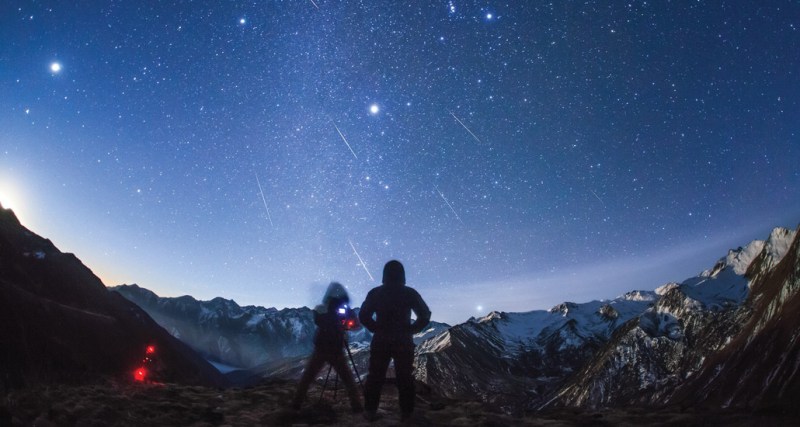
Instead, bundle up, head outside and look up, because meteors can streak through any part of the sky. The best place to look is probably wherever your sky is darkest and unobstructed by trees and artificial light. Give your eyes at least 20 minutes to get used to the dark.
If you are in North America, the show should start by 10 p.m. local time but will likely reach its peak after midnight. At maximum, you may see more than 100 meteors an hour. Most are white or yellow; all are slow and graceful, because the meteoroids orbit the sun in the same direction as Earth does. They hit the air at only 35 kilometers per second — versus 71 km/s for the Leonids, which occur in November and whose meteoroids orbit the sun backward, opposite the direction of Earth’s motion.







